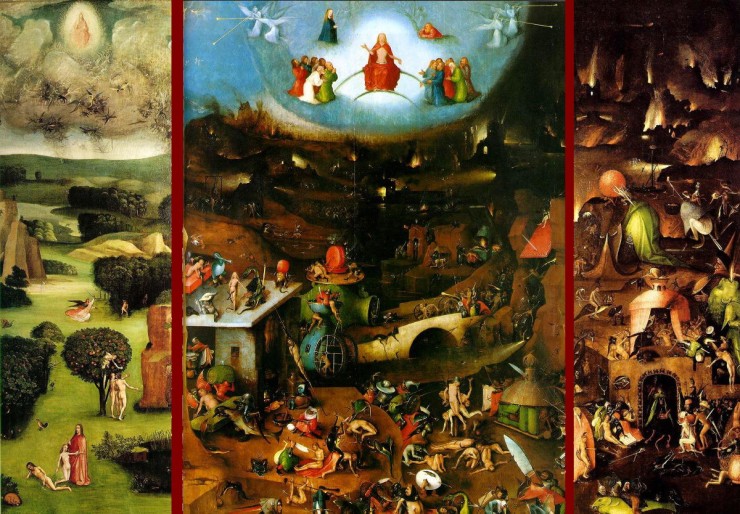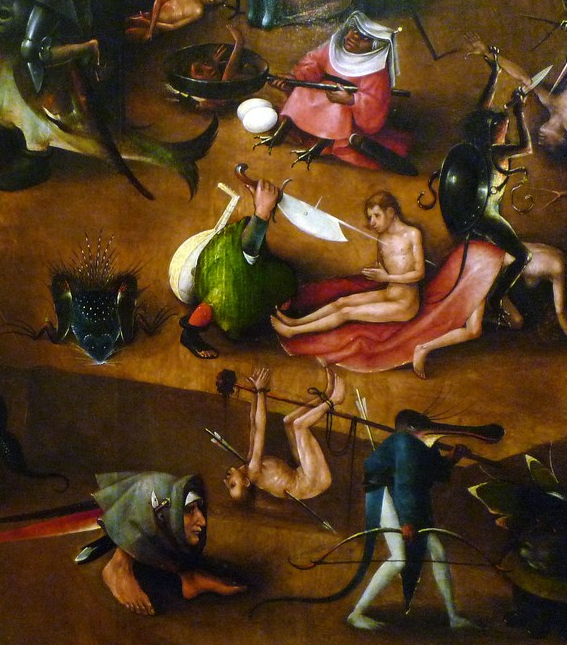Analysis of The Last Judgement

Description
The Last Judgement is a triptych, which is a piece of art that has three panels which can fold together to show the outer two panels. The outer two panels of Bosch’s piece show a saint on each panel. The saints are painted with tones of grey, light in value. These two panels are lacking intensity in the dull, grey colors used to paint the saints. However, the dullness of grisaille is contrasted with the intense oil paintings that are revealed by opening the outer panels.
The left wing depicts God in heaven above a slew of battling angels. Below God, you see the journey of Adam and Eve which begins with the creation of Adam and Eve, then the temptation of Adam and Eve at the tree, and finally you see Adam being expelled from the Garden of Eden. As a whole, the left wing illustrates the origin of sin.
The central panel follows suit and represents the wages of sin. Christ is shown at the top of this panel as well surrounded by much more peaceful angels. Below Christ is what has been described as the edges of hell. Human figures are caught in different sinful acts and are being tortured for those sins. The figures engaged in torturing the humans are odd combinations of animals and humans depicted as demons clothed in human garments. There are beings with the feet of frogs, nuns with only heads and feet, human bodies with the heads of birds or platypuses, and other frightening depictions of demonic beings. Humans are being boiled, stabbed, caged, bitten, waterboarded, and a litany of other types of torture.
All this torture at the edges of hell leads to the right panel, hell itself. Lucifer is in the bottom right of this panel, directly across from Christ at the top left when looking at the triptych as a whole. This panel is much darker in both tone and color. Lucifer is sitting on his throne with dark shading behind him. The doorway above is lined with frogs alluding to the frogs that had been torturing humans in the central panel. Above this throne is a hoard of humans who have been condemned to hell and are realizing the consequences of their sin. Above Lucifer and the citizens of hell is hell itself, is a fiery wasteland.
Connection to the Influences
Background
Hieronymus Bosch was born in the small Dutch town of s-Hertogenbosch. Very little about his life is known because he did not leave behind any texts like other artists of the time. There is no evidence he ever really ventured beyond his hometown and the nearby towns. In fact, the studio at which he made the art that was commissioned of him was a mere hundred yards or so from his home.
Humanism
Hieronymus Bosch’s works explore the consequences of human choice. As seen in this triptych, hell awaits those who indulge in sin. It makes the viewer consider how their choices might lead to an undesirable fate. Eliciting thoughts about good and evil are a part of the early development of humanism. This focus on the importance of human values is one of the main tenants of humanism and can be seen in most of Bosch’s works. He shows the viewers the miseries of hell to stress the importance of living a devout life and makes one truly contemplate the power of the choices they make. Considering Bosch only painted on commission and that during his time the church was a rich institution, it is not surprising most of his works explore religious themes and provoke a traditional fear of hell.
The odd juxtaposition of lifelike and fantastical creatures is an example of Bosch’s influence on surrealism. Salvador Dali, whom many have claimed is the founder of surrealism, studied Bosch’s works. Personally, the intense characters who are not man or animal catch my attention the most. The frightening depictions of human torture are aligned with either comically proportioned figures or hideously deformed monsters. You can also see that the crazy figures are cloaked in normality. Demons are wearing the clothes of everyday people. This creates a strangeness from the mundane just like surrealism. Personally, I am fascinated by this odd relationship and it is why I chose to analyze The Last Judgement.

Sources
Barker, Vicki. “Hieronymus Bosch Died 500 Years Ago, But His Art Will Still Creep You Out.” NPR. June 26, 2016. Accessed February 13, 2019. https://www.npr.org/2016/06/26/483225865/hieronymus-bosch-died-500-years-ago-but-his-art-will-still-creep-you-out
Erdmann, Robert G. “The Last Judgement.” Bosch Project. Accessed February 15, 2019. http://boschproject.org/#/artworks/The_Last_Judgment_Groeningemuseum
Harris, Dr. Beth and Zucker, Dr. Steven. “Hieronymus Bosch, Last Judgment Triptych.” Smarthistory. December 5, 2015. Accessed February 15, 2019. https://smarthistory.org/hieronymus-bosch-last-judgment-triptych/
Sooke, Alastair. “The Ultimate Vision of Hell.” BBC. February 19, 2016. Accessed February 14, 2019. http://www.bbc.com/culture/story/20160219-the-ultimate-images-of-hell
I really like the piece of art you chose. I found it pretty interesting that it folds to make another picture, I have never heard of paintings like that before. The close up you choose to ad on was a great idea because you can really see all of the odd characters the artist choose to use a demands, they are not super scary looking just odd. All around a great piece of art and your blog was really well written the painting just got more and more interesting the more I read it.
LikeLike
This piece is wonderful, I noticed how much detail artists put into their work its very impressive. Looking at it all at once makes it look like a jumbled mess but once you take the time too look into the details you begin to see a story being told all in the same painting. As you mentioned in this painting the figures in the middle frame are disfigured and have animal body parts. I believe the artist may be implying that there are many sinners in the world. They may all wear normal clothes and look normal but the artist shows who they really are and how they can tear into you and drag you down to hell with them.
LikeLike